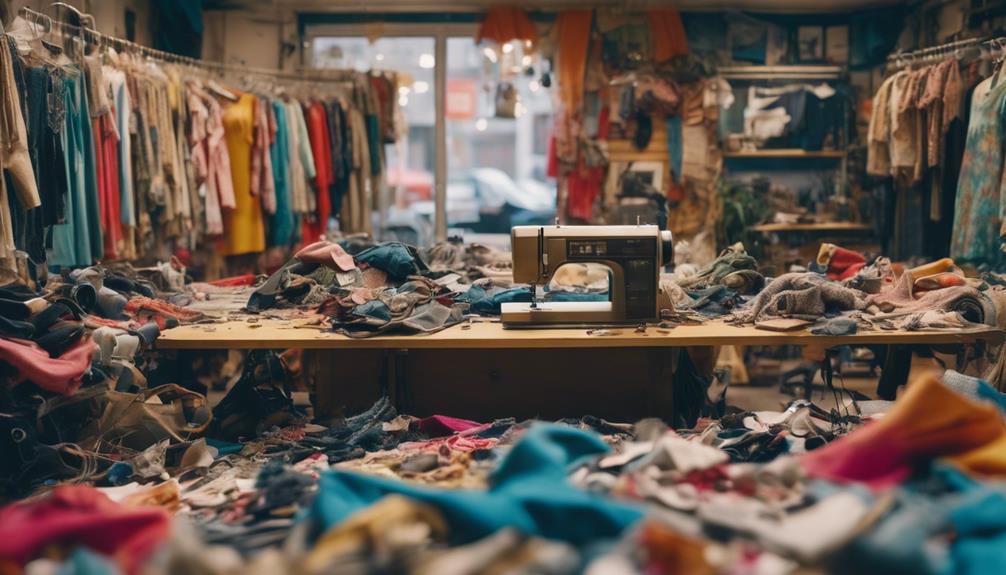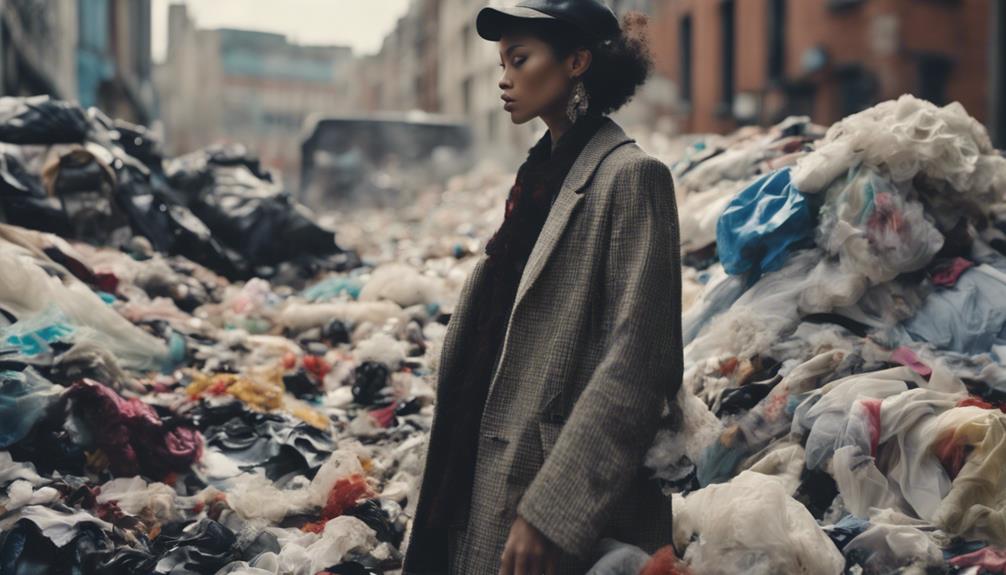Sustainable fashion can be budget-friendly, but it requires smart shopping. While ethical brands may come with higher initial prices, they prioritize quality, reducing the need for frequent replacements. Brands like Lora Gene and Ninety Percent offer affordable yet stylish pieces. Thrifting, clothes swaps, and rental options are additional ways to save money while supporting sustainability. Keep in mind that fast fashion may appear cheaper, but it carries hidden social and environmental costs. To make informed decisions about your wardrobe, explore more sustainable fashion options that align with your budget!
Key Takeaways
- Affordable ethical brands like Lora Gene and Ninety Percent offer stylish options without breaking the bank.
- Thrift stores provide unique secondhand clothing at lower prices, promoting budget-friendly sustainable fashion.
- Repairing and upcycling clothes minimizes waste and saves money, making sustainable choices economical.
- Investing in quality clothing reduces replacement frequency, leading to long-term savings and sustainable practices.
Industry Claims Vs. Reality
Examining the gap between the fashion industry's sustainability claims and the harsh reality reveals a troubling truth about its environmental impact. While many brands label themselves as sustainable, the reality often tells a different story. Fast fashion remains a dominant force, producing garments at a staggering rate, yet those low prices come with hidden costs. Take for example the popular brand Mango as sustainable fashion. While they may promote sustainable practices, the truth is that their production processes still contribute to pollution, water waste, and exploitation of labor. The gap between these claims and reality highlights the urgent need for greater transparency and accountability in the fashion industry. Only by truly committing to sustainable practices and embracing ethical production methods can brands begin to mitigate the environmental and social impact of their operations.
You might think you're supporting ethical brands, but the truth is that many sustainable brands still use non-biodegradable materials, perpetuating environmental harm. These brands often promote their efforts with flashy marketing, claiming to be “less unsustainable,” but that doesn't equate to true sustainability.
Furthermore, the workers who produce these garments frequently don't receive living wages, raising serious ethical concerns. You might wonder why the cost of a garment doesn't reflect its true environmental and social impact. It's crucial to recognize that genuine sustainability requires more than just a catchy label—it demands accountability and real change.
As you navigate your fashion choices, keep in mind that the industry's progressive image doesn't always match its actions, making it important to scrutinize those sustainability claims closely.
Innovations That Missed the Mark

Despite the excitement surrounding innovations in sustainable fashion, many of these initiatives have ultimately missed the mark in addressing the industry's environmental crisis. High-profile strategies like bio-based materials and recycling initiatives haven't notably reduced the fashion industry's overall environmental impact over the past 25 years. Concepts such as Rent-the-Runway, marketed as sustainable alternatives, have also fallen short in curbing environmental degradation and overconsumption.
One major issue is the misconception that sustainability exists on a spectrum. This leads you to believe that 'less unsustainable' products are equivalent to truly sustainable options, which is misleading. Many sustainable business models, including recycling, resale, and rental, often overlook the root causes of environmental degradation. As a result, they achieve limited effectiveness in reducing the industry's overall impact.
Moreover, the lack of regulatory intervention has allowed brands to promote misleading sustainability claims without accountability. This makes it challenging for you to identify genuinely sustainable options that are also affordable. As you navigate the world of sustainable fashion, it's vital to remain vigilant and discerning about the innovations and claims presented to you.
The Role of Regulations

You need to understand that regulations play a vital role in holding fashion brands accountable for their environmental impact.
By enforcing strict guidelines, governments can guarantee that companies adopt sustainable practices and disclose their production costs.
This accountability not only helps the planet but also empowers you as a consumer to make informed choices.
Accountability for Environmental Impact
Regulations play an essential role in holding fashion brands accountable for their environmental impact and promoting genuine sustainability practices. Without regulatory intervention, many brands could easily exaggerate their sustainability efforts, leaving you, the consumer, unsure of what's true. Current market solutions haven't effectively guaranteed transparency, making it vital for the government to step in and enforce stricter regulations.
These regulations can require brands to disclose their supply chain practices and environmental impacts, fostering a culture of accountability. For instance, only 2 out of the 250 largest fashion brands currently disclose living wage data. This highlights the urgent need for regulatory frameworks to guarantee fair wages and ethical labor practices.
Legislation like The FABRIC Act empowers you as a consumer to demand accountability from brands. With clearer guidelines, you can better assess which brands genuinely commit to sustainable practices.
Ultimately, regulations not only protect the environment but also create a more transparent industry, allowing you to make informed choices that align with your values. If fashion brands face regulatory scrutiny, they'll have a stronger incentive to adopt sustainable practices that benefit both the planet and its people.
Enforcing Sustainable Practices
The need for transparency in fashion practices makes enforcing sustainable regulations imperative for holding brands accountable and ensuring ethical production standards. With regulatory intervention, the fashion industry can tackle sustainability issues that market solutions have overlooked. For example, legislation like The FABRIC Act can drive significant change by demanding better labor practices and environmental commitments from companies.
Here's how effective regulations can impact the industry:
| Aspect | Impact of Regulations |
|---|---|
| Transparency | Brands must disclose supply chain practices, revealing true costs of production. |
| Labor Practices | Enforces fair wages and safe working conditions across the board. |
| Environmental Commitments | Holds companies accountable for their environmental impact, reducing pollution and waste. |
| Sustainable Practices | Encourages innovation in eco-friendly materials and production methods. |
Without strict regulations, fast fashion brands exploit low costs and neglect ethical production. By creating a framework that promotes accountability, we can shift towards sustainable practices that benefit both the planet and workers. Your choices as a consumer matter, but regulatory support is essential for meaningful change.
Evaluating New Business Models

Evaluating new business models in sustainable fashion reveals a complex landscape where consumer behavior and industry practices must work hand-in-hand to drive genuine impact. While innovations like recycling, resale, rental, and repair are marketed as eco-friendly solutions, their effectiveness often falls short. Many of these approaches only address the symptoms of overproduction and environmental degradation rather than tackling the root causes.
You might think that the rise of rental and resale markets would lead to significant reductions in garment production and waste. However, many consumers continue to purchase new items while using these services, limiting their potential environmental impact. Ethical brands endeavor for small-batch production to avoid overproduction, but the financial risks tied to unsold inventory create tension between sustainability and profitability.
To truly shift the landscape towards sustainable fashion, collaboration across the industry is essential. It's not enough for brands to innovate in isolation; systemic change is needed to enhance the effectiveness of these new models. By aligning consumer behavior with ethical practices, we can foster a more sustainable future in fashion that genuinely addresses the pressing environmental challenges we face.
Future Directions for Sustainability

Exploring innovative strategies for sustainability in fashion requires a collective effort from brands, consumers, and policymakers to create lasting change. You play a significant role here. By demanding sustainable and affordable fashion options, you can encourage brands to prioritize ethical production methods. This means supporting initiatives that prioritize fair wages for workers and minimize environmental impact.
Collaboration is key. When brands work together, they can share resources and knowledge to innovate sustainable practices more effectively. For you, this could mean choosing to shop from brands that actively participate in such collaborations.
Moreover, regulatory frameworks need to be established to hold companies accountable for their environmental impacts. This would guarantee that sustainability isn't just a marketing gimmick but a standard practice. As consumers, you can advocate for these changes by staying informed and engaging in conversations about the true costs of fashion.
Lastly, education on the impact of your choices is essential. Understanding the long-term benefits of investing in sustainable fashion can guide you toward making better purchasing decisions. Together, through informed choices and advocacy, we can pave the way for a more sustainable future in the fashion industry.
Myths Surrounding Fast Fashion

Believing that fast fashion is the only way to stay trendy and within budget often blinds consumers to its hidden costs. Fast-fashion brands tout low prices, but these come at a significant ethical and environmental expense. You might think you're scoring great deals, but the reality is that only 2% of garment workers earn a living wage globally. This exploitation fuels a culture of overconsumption, where the average American buys around 70 garments a year—up from just 25 in 1960.
Many consumers justify their purchases by viewing fast fashion as a necessity, but this perspective overlooks the benefits of sustainable fashion. Ethical brands may have higher upfront costs, yet they often provide better quality and durability, leading to long-term savings. When you invest in sustainable options, you're not just buying fashion; you're supporting fair labor practices and reducing environmental damage.
Embracing Affordable Sustainable Options

You can easily embrace sustainable fashion without stretching your budget.
Many ethical brands offer stylish options that compete with fast fashion prices, and shopping second-hand or swapping clothes with friends can save you even more.
Plus, investing in quality pieces means you'll spend less over time, as these garments last longer and require fewer replacements.
Budget-Friendly Sustainable Choices
Affordable sustainable fashion is within reach, thanks to a growing number of ethical brands and innovative shopping options that prioritize both style and budget. You don't have to sacrifice your wallet to make eco-friendly choices. Here are some budget-friendly ideas to embrace sustainable fashion:
- Explore ethical brands: Look for mid-priced options like Lora Gene and Ninety Percent, which offer quality garments without the hefty price tag.
- Shop at thrift stores: Discover unique secondhand clothing treasures at consignment shops, where you can score stylish pieces for a fraction of the price.
- Repair and upcycle: Instead of tossing old clothes, consider repairing or transforming them into personalized fashion items. This not only saves money but also minimizes waste.
Value of Quality Investments
Investing in quality clothing not only enhances your wardrobe but also offers significant long-term savings by reducing the frequency of replacements. When you choose ethical brands that prioritize sustainable materials, you're making a smart investment. Though the price tag may be higher initially, these garments often outlast fast fashion items, ultimately lowering your cost per wear.
Mid-priced ethical brands, like Lora Gene and Ninety Percent, provide quality alternatives without breaking the bank. As consumer behavior shifts towards valuing sustainability, these brands are increasingly accessible. You can also explore affordable sustainable fashion options through thrifting, swapping, or renting, which minimize your environmental impact while keeping your style fresh.
Awareness of the true costs in garment production can lead you to prioritize quality over quantity. By embracing this mindset, you not only support ethical practices but also contribute to a more responsible fashion industry.
Understanding True Costs of Fashion

Recognizing the true costs of fashion means looking beyond the price tag to understand the hidden social and environmental impacts embedded in our clothing choices. When you assess the cost of a Zara dress, it's vital to realize that the price reflects not just production costs but also the exploitation of workers and the environmental toll. Fast fashion's allure often obscures the true cost of these garments.
Here are some key points to evaluate:
- Low workers' wages: Brands like Zara allocate only a fraction of the retail price to workers, raising ethical concerns.
- Environmental impact: Fast fashion leads to overproduction and waste, with consumers buying 60% more clothing that lasts half as long.
- Exploitation in supply chains: Labor costs represent only about 3% of the total retail price, highlighting systemic issues.
Frequently Asked Questions
Do People Really Care About Sustainable Fashion?
You might think people care about sustainable fashion, and many do. However, there's often a disconnect between concern and action. While interest grows, affordability perceptions hinder widespread commitment to sustainable choices in clothing.
Does Sustainable Fashion Really Work?
Does sustainable fashion really work? Imagine a world where every garment saves the planet! You'll discover that it not only reduces environmental harm but also promotes ethical practices, making a positive impact with every stylish choice you make.
Why Is Sustainable Fashion Unaffordable?
Sustainable fashion often feels unaffordable because it prioritizes fair wages and quality materials. While fast fashion lures you with low prices, those savings come at a cost to workers and the environment you might not see.
What Is the Paradox of Sustainable Fashion?
The paradox of sustainable fashion lies in its perception; while ethical brands seem expensive, investing in quality leads to savings over time. Fast fashion's low prices hide environmental and social costs, complicating your choices.
Conclusion
In the tapestry of fashion, sustainability doesn't have to be a luxury thread; it can be woven into the fabric of affordability.
By seeking out innovative brands and supporting ethical practices, you can embrace style without sacrificing your budget.
Don't let myths about fast fashion cloud your choices.
Instead, step into a brighter future where conscious decisions and chic outfits coexist.
You've got the power to redefine what fashion means for you and the planet.








